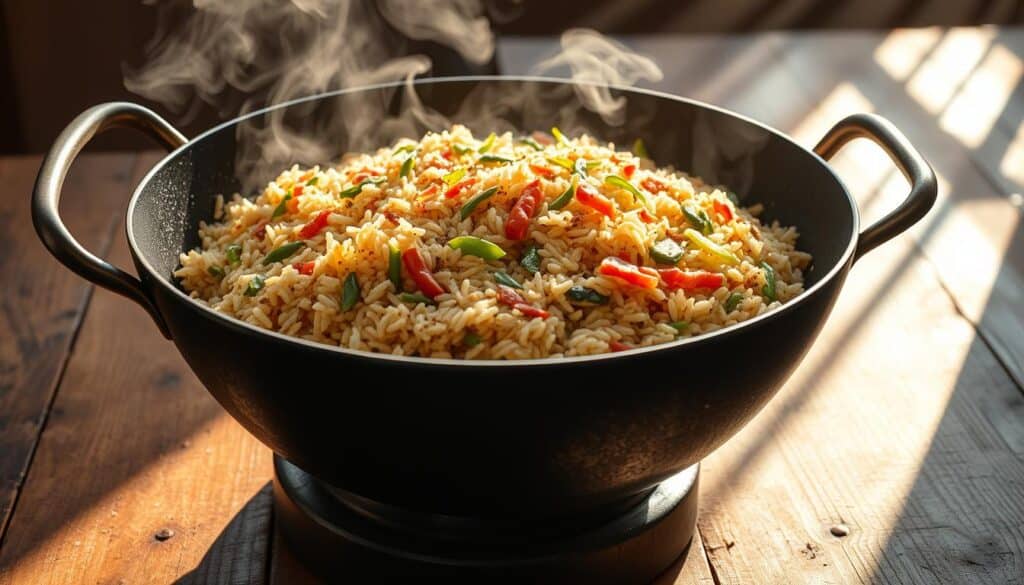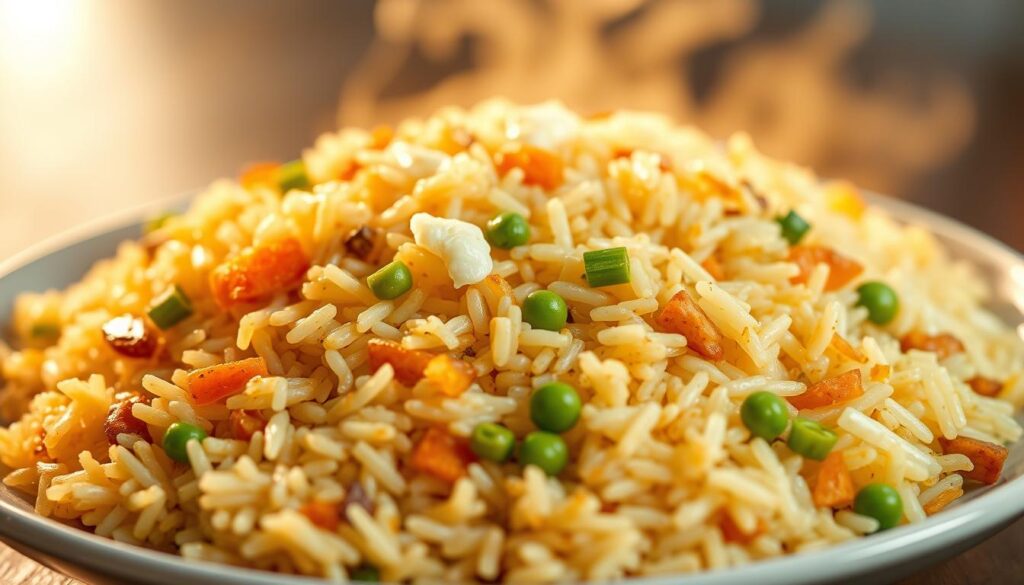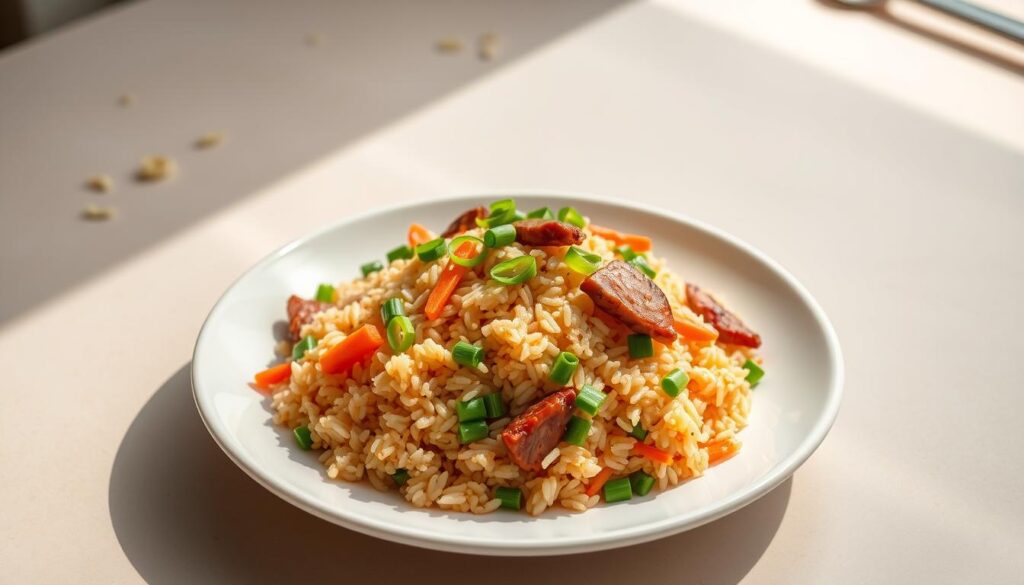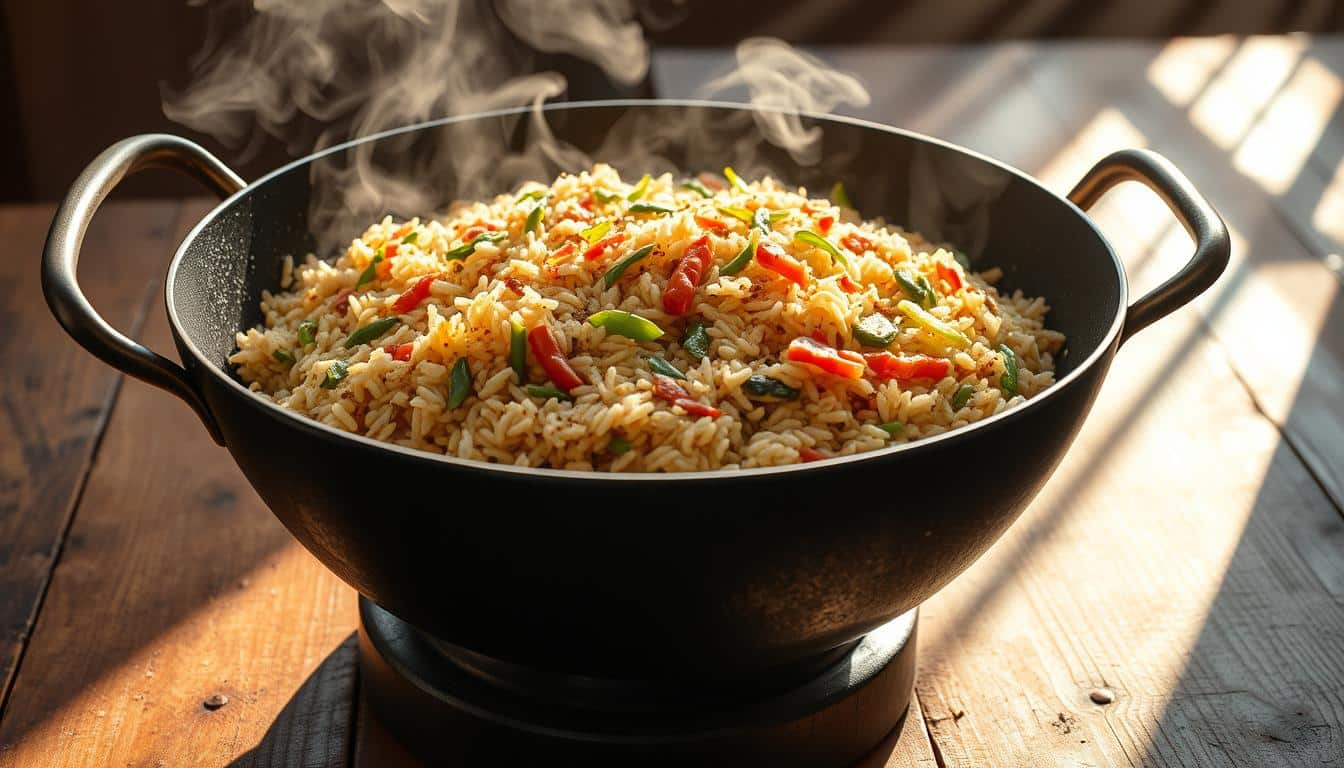There’s something special about a perfectly cooked plate of fried rice. It’s more than just a meal; it’s a way to bring people together. I’ve always loved how this dish transforms simple ingredients into something truly satisfying. Whether it’s a quick weeknight dinner or a weekend gathering, fried rice never disappoints.
Thank you for reading this post, don't forget to subscribe!
This fried rice recipe is a go-to for many reasons. First, it’s incredibly versatile—perfect for using up leftovers. Second, it’s ready in just 15 minutes, making it a lifesaver for busy evenings. And third, it’s packed with flavor, from the savory soy sauce to the pop of color from fresh vegetables.
What I love most about this dish is how customizable it is. You can add your favorite proteins like chicken or shrimp, toss in some frozen peas, or even sprinkle a bit of sesame oil for that extra oomph. It’s a meal that adapts to your tastes and what you have on hand.
So, if you’re looking for a recipe that’s both comforting and quick, this fried rice is your answer. It’s a dish that never fails to hit the spot, and I’m excited to share how easy it is to make it at home. Plus, it pairs perfectly with other sausage and rice recipes for a well-rounded meal.
Key Takeaways
- A quick and versatile meal ready in 15 minutes
- Perfect for using up leftovers
- Customizable with your favorite proteins and vegetables
- Flavorful with soy sauce and sesame oil
- Great for busy weeknights or casual gatherings
My Introduction to a Beloved Recipe
My journey with fried rice began in a small, cozy restaurant where the aroma of sizzling ingredients and the warmth of the staff made every visit special. Those Saturday lunches sparked a deep connection to this dish, turning it into more than just a meal for me.
My Personal Story with Fried Rice
As a child, I cherished our Saturday tradition at a local restaurant. The chef’s mastery in combining eggs, carrots, and onions into a harmonious blend fascinated me. Each bite was a lesson in balance and simplicity.
What I loved most was how the chef transformed leftovers into something extraordinary. This approach inspired me to experiment in my own kitchen, leading to countless trials until I perfected my recipe.
What Makes This Recipe Special
This fried rice holds a special place in my heart because it’s a testament to resourcefulness and flavor. Using leftover rice is crucial for achieving that signature texture—crunchy yet tender, never mushy.
The sauce is the soul of the dish. A blend of soy sauce and a touch of sweetness creates a depth that elevates each bite. It’s a balance that makes this recipe stand out, just like those unforgettable Saturday lunches.
Essential Chinese fried rice Ingredients
Creating a delicious fried rice dish starts with the right ingredients. Each component plays a vital role in achieving that perfect balance of flavors and textures.
Staple Ingredients and Leftovers
The foundation of a great fried rice recipe lies in its staple ingredients. White rice is the star, but it must be day-old and completely cooled to ensure the best texture. Fresh rice is too moist and will result in a mushy dish. Alongside the rice, eggs, garlic, carrots, onions, and green peas are essential. These vegetables add natural sweetness and vibrant colors to the dish.
Balancing Sauces and Seasonings
The sauces are what bring the dish to life. Oyster sauce and sesame oil are must-haves, contributing a savory, nutty flavor. Use about 1 tablespoon of each for a balanced taste. Garlic, finely minced, adds an aromatic depth, while a mix of vegetables provides freshness and crunch.
- 2 cups of day-old white rice
- 3 large eggs
- 5 cloves of minced garlic
- 1 large carrot, diced
- 1 large onion, chopped
- 1 cup of green peas
- 1 tablespoon of oyster sauce
- 1 tablespoon of sesame oil
Measuring ingredients correctly is key. Use tablespoons to ensure the right amount of sauces and oils. Quality matters, so choose fresh vegetables and real ingredients for the best flavor.
Step-by-Step Preparation Instructions
Creating a delicious fried rice dish is easier than you think! With a few simple steps, you can achieve that perfect texture and flavor. Let’s break it down into manageable parts so you can cook like a pro.
Scrambling Eggs and Prepping Veggies
Start by heating a tablespoon of oil in a skillet over medium heat. Add 3 large eggs and scramble them until they’re just set. Set aside the eggs for later. Next, dice 1 large carrot and 1 onion, and mince 5 cloves of garlic. Sauté these veggies in the skillet for about 2-3 minutes until they soften. This step adds natural sweetness to your dish.
Combining Ingredients in the Pan
Add 2 cups of cold rice to the skillet, stirring to mix with the veggies. Pour in 1 tablespoon each of oyster sauce and sesame oil. Stir everything together for 2-3 minutes on high heat to ensure even browning. Finally, add the scrambled eggs back into the mix and stir for another minute. Let it cook undisturbed for 30 seconds to get that nice crust at the bottom.
Techniques for Achieving Perfect Texture
Achieving the ideal texture in fried rice is all about balance—crunchy, yet tender, with grains that don’t stick together. The secret lies in how you handle the rice and apply heat.
Using Chilled Versus Fresh Rice
Day-old rice is a must for fried rice. Fresh rice is too moist, leading to a mushy texture. Chilling rice allows starches to retrograde, making the grains separate and firm. I’ve found that cooling rice with a fan works better than refrigerating it, as it dries the rice evenly.
High Heat and Browning Methods
High heat is key to crisping the rice. Use a nonstick pan and let the rice sit for a few seconds between stirs to develop a golden crust. This technique, which I learned through trial and error, ensures a perfect crunch without burning.
| Rice Type | Texture | Best For |
|---|---|---|
| Day-old Rice | Firm, Separate Grains | Fried Rice |
| Fresh Rice | Mushy, Sticky | Other Dishes |
By mastering these techniques, you’ll create fried rice that’s moist, crunchy, and full of flavor.
Customizing Your Fried Rice with Unique Mix-Ins
One of the best things about fried rice is how easily you can make it your own. Whether you’re in the mood for something classic or adventurous, there’s always room to add a personal touch.
Exploring Vegetable and Fruit Variations
Vegetables add color, texture, and freshness to your dish. Green peas, carrots, and onions are staples, but don’t be afraid to get creative. Corn kernels or diced bell peppers can add a sweet crunch, while a handful of chopped cabbage brings in a nice crispness.
For a surprising twist, try adding some fruit! Pineapple chunks or diced apples can create a sweet and savory contrast that elevates the dish. These additions not only make your fried rice more interesting but also balance the flavors beautifully.
Protein Options: Chicken, Beef, Shrimp, and More
Adding protein turns your fried rice into a hearty meal. Shredded rotisserie chicken is a convenient option, while diced beef or tofu offers a robust texture. If you’re a seafood lover, shrimp adds a delicious burst of flavor.
Another great choice is pork—diced ham or cooked bacon bits can add a smoky, savory element. Remember, the key is to use pre-cooked proteins to save time and ensure they’re evenly distributed throughout the dish.
When experimenting with mix-ins, always use a measured cup of cooked rice to maintain consistency. A drizzle of extra oil helps everything blend smoothly, ensuring each bite is flavorful and well-balanced. Feel free to adjust the recipe to match your taste preferences while keeping the base authentic. The possibilities are endless, so don’t hesitate to get creative and make your fried rice truly special!
Tips for Perfect Seasoning and Flavor Balance
Seasoning is where the magic happens in fried rice. It’s all about finding that perfect harmony of flavors that makes each bite delightful. I’ve learned that less is often more when it comes to sauces and seasonings. Start with a light hand and adjust to taste.
Mastering Soy Sauce and Oyster Sauce Usage
Soy sauce is the backbone of fried rice seasoning. I add it early in the cooking process to let the rice absorb the flavors. Oyster sauce, on the other hand, is used sparingly for its rich, savory taste. Together, they create a balanced umami flavor without overwhelming the dish.
Finishing Touches with Toasted Sesame Oil
A drizzle of toasted sesame oil at the end adds a nutty aroma and a touch of sophistication. It’s important to use it in small amounts to avoid overpowering the other flavors. This final step brings everything together beautifully.
- Use 2 tablespoons of soy sauce for 2 cups of rice.
- Add a teaspoon of pepper for a subtle kick.
- Taste as you go to ensure the seasoning is just right.
- Stir continuously in a well-heated pan for even flavor distribution.
| Seasoning Approach | Technique | Result |
|---|---|---|
| Light Initial Seasoning | Add soy sauce and pepper sparingly at the start. | Allows for easy adjustments without overwhelming the dish. |
| Final Drizzle | Drizzle sesame oil at the end of cooking. | Enhances aroma and adds depth to the flavor profile. |
| Continuous Stirring | Stir the rice constantly in a hot pan. | Ensures even distribution of flavors and textures. |

For more tips on achieving the perfect seasoning, visit Real Simple for expert advice. Remember, the key to great fried rice is balance—let the flavors complement each other without any single ingredient dominating the dish.
Visual Guide: A Quick 1-Minute Video Overview
Discover the art of making this dish in just a minute! Our quick video guide condenses the recipe into bite-sized steps, making it easy to follow along.
Watch and Learn the Process
The video starts by showing how to heat a skillet and add a tablespoon of oil. You’ll see the proper stir-frying motion and how to measure ingredients using cups for an authentic look. Feel free to pause and rewatch any part to master each step.
- Witness key steps like adding oil to a hot pan.
- Learn the correct stir-frying technique.
- See how to measure ingredients using cups and a skillet.
- On-screen text cues match the written instructions for clarity.
This visual guide complements the written instructions, reinforcing proper technique and timing. It’s designed to help you cook with confidence, whether you’re a novice or an experienced cook.
Advanced Techniques and Fried Rice Myths Debunked
When it comes to making exceptional fried rice, understanding the science behind the ingredients and techniques is key. Let’s dive into some advanced tips and debunk common myths to help you master this dish.
Day-Old Rice vs. Fresh Rice: The Science Behind It
The age of the rice significantly impacts the final texture. Day-old rice is preferred because it has dried out slightly, making it easier to separate the grains during cooking. Fresh rice, on the other hand, is too moist and sticky, leading to a mushy texture when stir-fried. The process of starch retrogradation is what makes day-old rice ideal—starches recrystallize, giving the rice a firmer texture that holds up well to high heat.
Batch Frying Tips and Optimal Heat Control
One common myth is that you need to let rice sit for days before using it for fried rice. In reality, just one day is enough. Another misconception is that you need a professional wok to achieve the perfect texture. While a wok is ideal, you can still make great fried rice on a Western stovetop by cooking in small batches. This prevents the rice from steaming instead of frying, ensuring each grain gets the right amount of crispiness.
High heat is crucial for achieving that elusive wok hei (breath of the wok), but be careful not to burn the rice. Stir-fry in quick, precise motions, letting the rice sit for a few seconds between stirs to develop a nice crust. This technique ensures your fried rice is crispy on the bottom and tender throughout.
When adding sauces like soy sauce or oyster sauce, do it sparingly to avoid overpowering the dish. A light hand when seasoning allows the natural flavors of the ingredients to shine through, creating a balanced and delicious meal.
Serving Suggestions and Complementary Side Dishes
When it comes to serving fried rice, the right sides can elevate your meal from simple to spectacular. I love how versatile this dish is—it pairs well with everything from light soups to hearty proteins. Whether you’re aiming for a balanced family dinner or a casual gathering, these serving suggestions will help you create a memorable dining experience.
What to Serve with Fried Rice
For a classic combination, try pairing your fried rice with a bowl of egg drop soup. Its light, savory broth complements the rich flavors of the rice perfectly. If you prefer something greener, a side of stir-fried greens adds a refreshing contrast. I also enjoy garnishing my fried rice with chopped scallions or a sprinkle of toasted sesame seeds for added aroma and crunch.
When it comes to proteins, lean options like grilled chicken or shrimp work beautifully. For a vegetarian twist, roasted or sautéed vegetables like broccoli or carrots make a delicious match. Timing is key—serve the dish hot to maintain its crispy texture, and don’t hesitate to adjust the seasoning with a teaspoon of soy sauce or sesame oil for that extra burst of flavor.

Remember, the goal is to create a well-rounded meal that’s both satisfying and visually appealing. Experiment with different combinations to find your perfect pairing!
Conclusion
With just a few simple steps, you can create a delicious and satisfying meal that’s ready in no time. This recipe proves that cooking doesn’t have to be complicated to be flavorful. By using leftover ingredients and a mix of fresh vegetables, you can craft a dish that’s both budget-friendly and mouthwatering.
Feel free to experiment with the recipe by adding your favorite proteins or vegetables. A dash of soy sauce or an extra egg can elevate the flavors to your liking. Remember, the key is to balance the ingredients so each bite is a harmony of tastes and textures.
Whether you’re a busy professional or an adventurous home cook, this fried rice is a versatile option for any occasion. Take a moment to explore Chinese fried rice variations for even more inspiration. Thanks for joining me on this culinary journey—give the recipe a try and enjoy the delightful results!
FAQ
What is the best type of rice to use for fried rice?
The best rice for fried rice is day-old cooked rice. It dries out a bit, which helps create a better texture. Avoid using freshly cooked rice, as it’s too moist and sticky.
Can I use leftover rice?
Absolutely! In fact, leftover rice is ideal because it’s drier and separates better when stir-fried. Just make sure it’s cooled completely before using it.
How much soy sauce should I add?
Start with about 2 tablespoons of soy sauce and taste as you go. You can always add more, but it’s harder to remove excess soy sauce once it’s stirred in.
Can I make fried rice without egg?
Yes, you can skip the egg if you prefer. Simply omit it and add your favorite protein like chicken, beef, or tofu instead.
What vegetables are best for fried rice?
Carrots, peas, and onions are classic choices. You can also add frozen peas, diced bell peppers, or even chopped zucchini for extra flavor and texture.
Can I use frozen peas?
Yes, frozen peas work great! Just thaw them first by leaving them in room temperature for a few minutes or rinsing them under warm water.
What’s the difference between soy sauce and oyster sauce?
Soy sauce adds a salty, umami flavor, while oyster sauce is sweeter and richer. Use both for a balanced taste, or choose one based on your preference.
Do I need sesame oil?
Sesame oil is optional but recommended for its distinct flavor. Use a small amount (about 1 teaspoon) to finish the dish for a nutty aroma.
Can I make fried rice without soy sauce?
Yes! If you don’t have soy sauce, you can use a mixture of salt and a splash of vinegar to season the dish. It won’t taste the same, but it’ll still be delicious.
Why should I cook fried rice on high heat?
High heat ensures the ingredients cook quickly and evenly, preventing the rice from becoming mushy. It also helps caramelize the flavors for a better taste.
Can I store leftover fried rice?
Yes, you can store fried rice in an airtight container in the fridge for up to 3 days. Reheat it in a pan or microwave before serving.
There are no reviews yet. Be the first one to write one.

